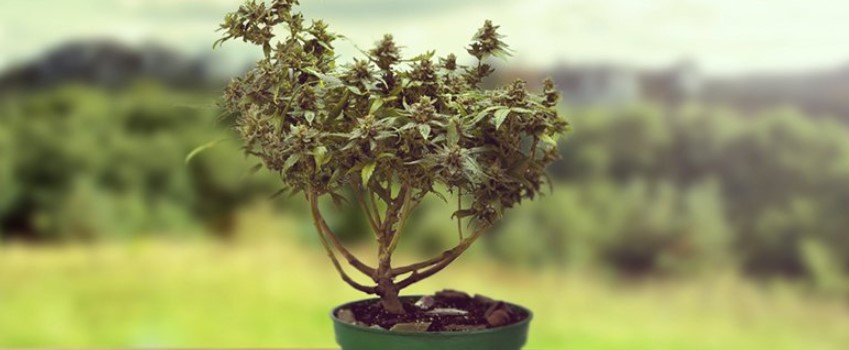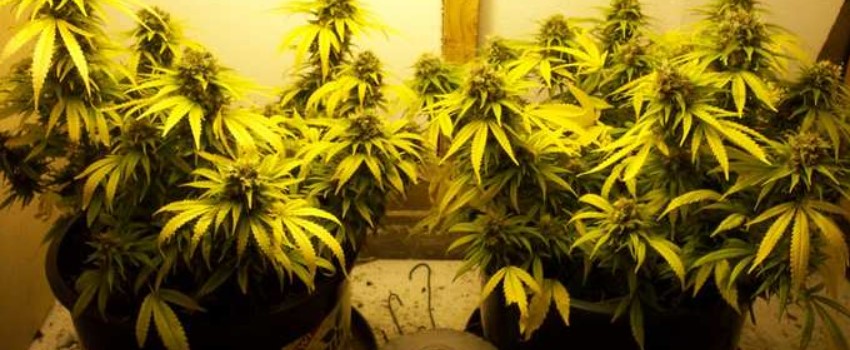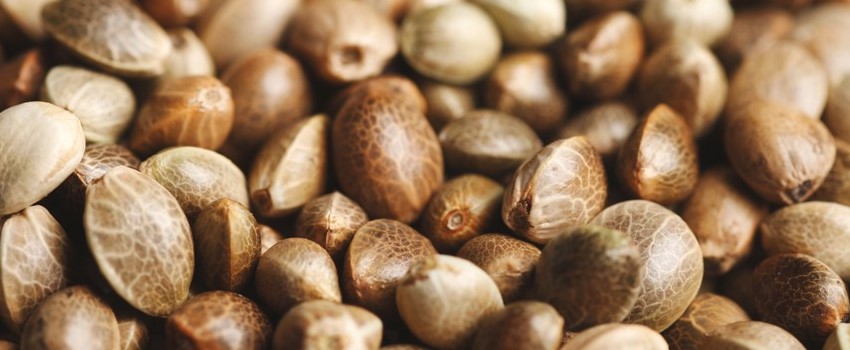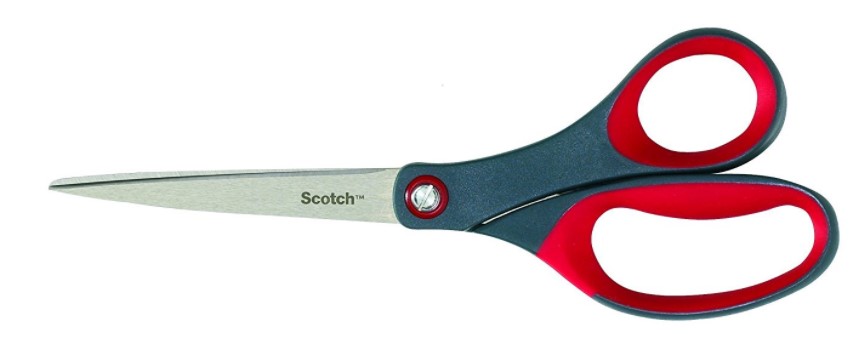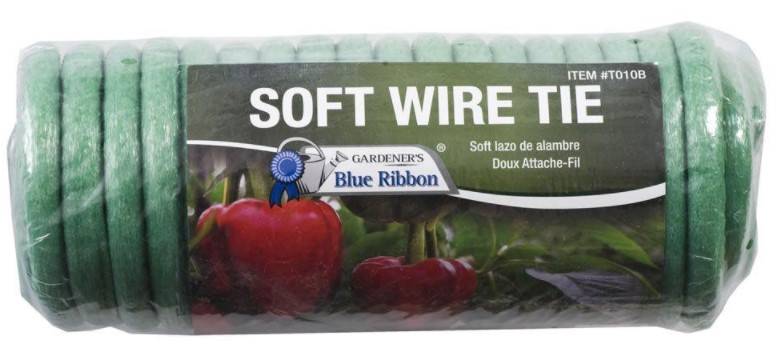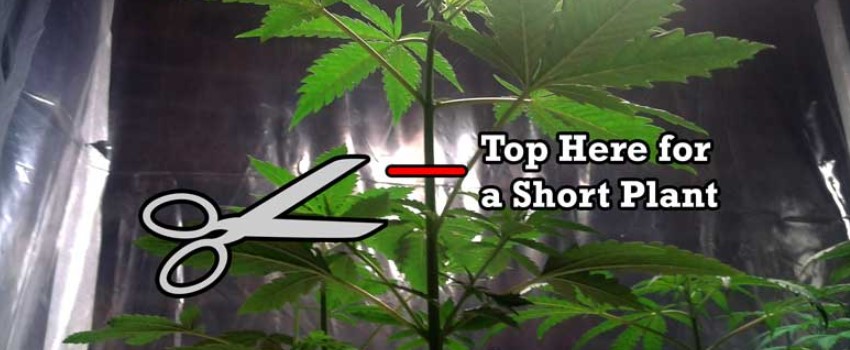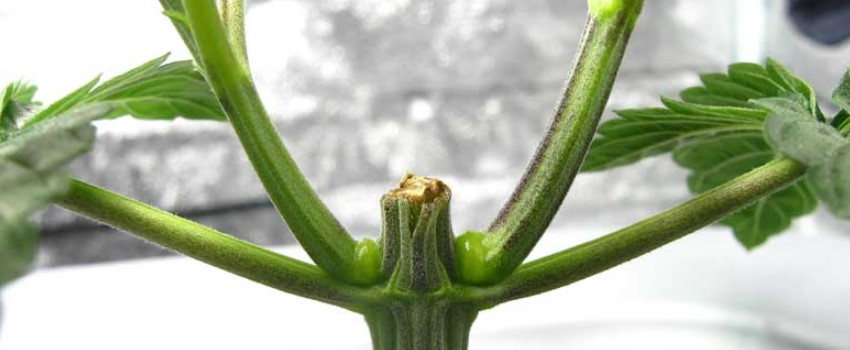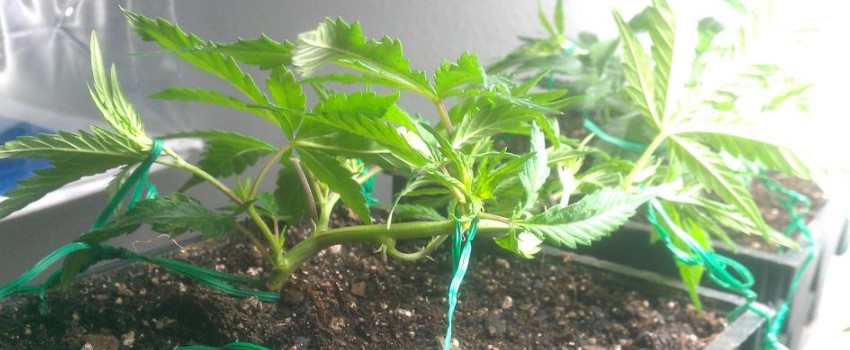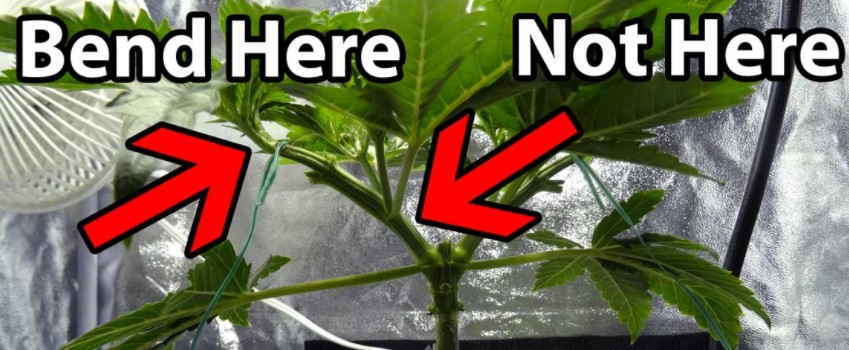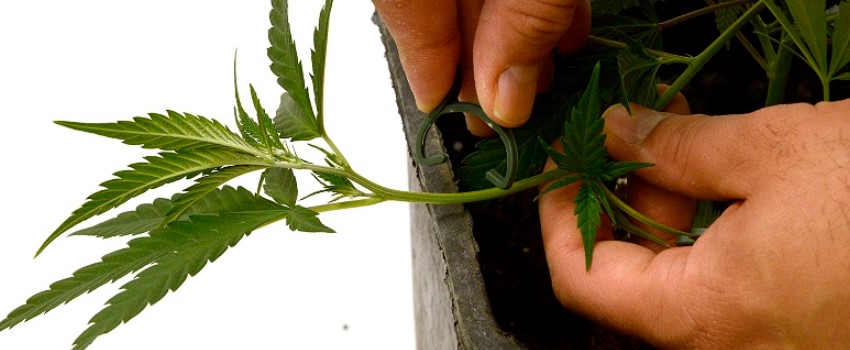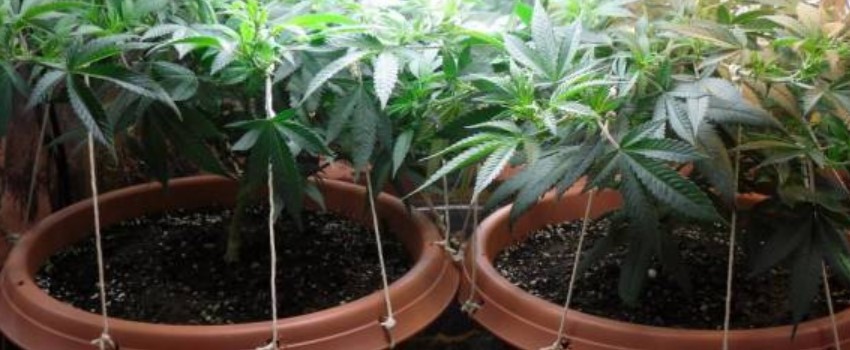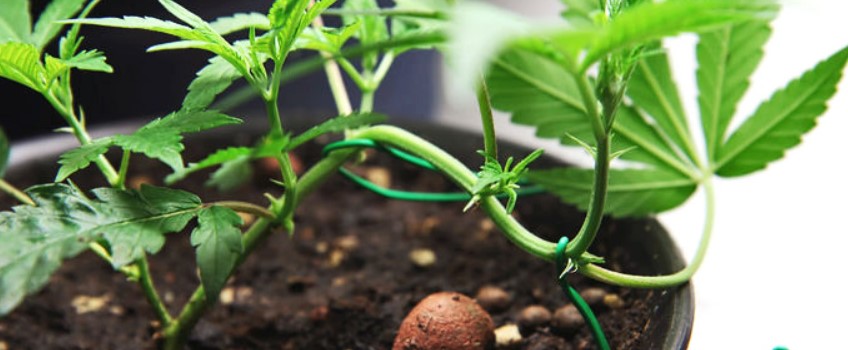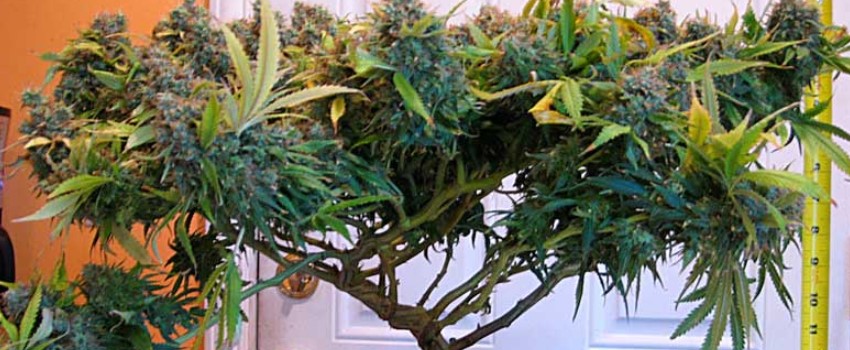When it comes to growing a lot of weed, no gardening trick is easier to execute than Low-Stress Training (LST).
As its name suggests, this method inflicts slight stress which is less burdensome for the plant.
Low Stress Training
But its main attraction is how cannabis plants tend to grow wide and bushy once we apply it.
This means more branches for bud sites to develop. As a bonus, the stress from bending spikes up the production of THC resulting in more potent buds.
For many bud growers, LST is a popular choice due to its ease and safety in application.
As such, there’s no need to cut or split the stems which could kill the plant if not done right.
Essentially, we only need to gently bend and tie the tall stems to put them on the same layer as the shorter ones.
Hence, even newbie growers can practice it without fear of harming the crop.
Download my free Grow Bible for more tips on advanced growing techniques.
Grow Bible

- Grow with my Quick Start Guide
- Discover secrets to Big Yields
- Avoid common grow mistakes
Error: Contact form not found.
The main goal of LST is to pull the branches away from the center and position them in such a way that they get more light.
As a result, there is more space for plenty of bud sites or colas to develop.
Overall, we can expect a boost in plant growth and leaf development as well as a significant increase of fat and chunky buds.
In indoor gardens where space is limited, LST helps keep the plant short but productive.
Oftentimes, we can get triple the bud sites due to the optimal use of light. But most of all, we get an amazing yield without spending more on equipment or nutrients.
So, in this article, we’ll talk about the steps on how to practice this gardening trick to boost our harvest.
Fortunately, it’s simple to follow and extremely effective once we apply it to our cannabis crop.
How to Get More Buds Using LST
Like cultivating bonsai, using LST on a marijuana plant results in a work of art.
As such, we can enjoy how short and stunning it looks as it produces so many buds. But before we start bending some stems, make sure to learn the science behind the method so we can use it to the fullest.
Understand How It Works
Once we understand the idea behind LST, we can better use it to our advantage. So, read on and learn the vital elements that make this method work.
The Right Distance
Normally, the marijuana plant grows vertically and produce one main branch and several tiny ones.
However, if we bend the branch at a proper distance from the center, it gives way to more growths. So, make sure to give plenty of space between the stems when starting out.
This will expose the growing leaves to optimum light which often enhances the overall growth.
The Sweet Spot
In LST, the sweet spot is that space where the right intensity of light falls.
As it gets farther away, light intensity drops and so does the useful energy for photosynthesis.
Hence, it is of utmost importance that the leaves occupy the sweet spot in the grow room.
As we bend the branches lower and away from each other, we help them find the sweet spot of light energy.
Combined with the proper distancing, this makes LST an effective method for increasing yield.
The Need to Top
Topping involves cutting out the top of the main branch to activate the growth of more branches.
Also, it allows the lower growths to rise and add to the number of bud sites.
While this is not required for LST, we get a lot more positive results if we set the stage for it.
This is why many growers top their plants in combination with other gardening tricks.
However, if we are growing auto-flowering strains, it is best to skip the topping part.
This is because it takes only 2-3 months to grow which means that it doesn’t have time to recover if we do the topping wrong.
However, some experienced growers can manage to do top this type of strain.
The Suitable Strain
In general, if done with gentle pressure and the right technique, all strains respond favorably to LST.
But many growers prefer Indicas due to the chance to improve flowering on the side branches.
When there is a bit more space in the grow room, some people choose to grow Sativas to get even higher yields.
Sativas can handle humidity and heat much better, which makes them ideal for growing indoors during the summer.
Gather the Materials
It’s important to try the LST technique on healthy young marijuana plants since they often have no problem bouncing back.
Also, they are at the stage where they normally grow a lot of leaves which is key for this method to flourish.
Other things we’re going to need are listed below as well as details for their use.
Sharp Scissors
While ordinary scissors can get the job done, it’s important to use sharp ones as the wounds they produce tend to recover much faster.
This way, we avoid infection from occurring to the stems and allow the plant to concentrate more on producing more growths.
Twisty Ties
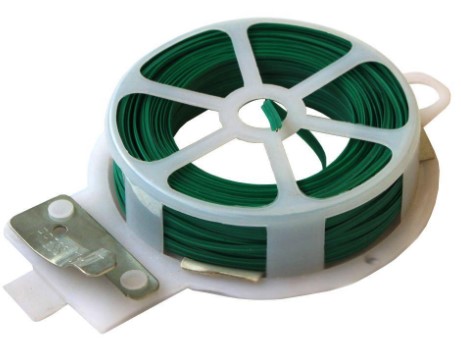
When bending the stems, we need to fasten them into place by using twisty ties.
This material is soft and adjusts quickly to the form we want so it avoids hurting the fragile stems.
In general, it’s okay to use other tying materials but make sure that they’re not thin enough to cut the plant.
Many growers warn against using strings as they easily make accidental cuts.
Soft Wire Ties
Bigger plants with stronger branches are easier to tie down using soft wire ties.
So, learn to adjust and choose the right type of tie depending on the size of the stems.
This is vital in executing an effective LST.
Start Training the Plant
Now that we know some basic ideas behind LST as well as the necessary tools to use, it’s time to start doing it.
To make things easy to understand, we divide the steps into three and emphasize the important tips.
Step 1: Top the Plant
While some growers prefer to skip this step, topping can give the plants a big advantage.
As mentioned, it allows the growth of more new colas as well as give the plant a chance to grow wider.
To do this, use the sharp scissors and make sure to sterilize them before cutting the stems.
This helps prevent infection and helps in faster healing of the open wounds.
Start topping once the plant has 4-6 nodes, cutting it down to the 3rd node which allows for a more symmetric base.
Once the cut is done, we can see two little growth tips on the same stem.
Be careful not to injure them as they will grow several new nodes after a while.
Once the new ones create 4-6 nodes, then we can top them too to make more branches.
Important Tips to Remember
To get the best results, we emphasize the following tips. Make sure to follow them as they are vital for LST to work.
Don’t Top Too Early or Too Late
As mentioned, let the plant grow 4-6 nodes before topping, and not earlier or later than that.
The explanation is, if we start cutting before it grows 4 nodes, then the plant may be too young to recover.
On the other hand, if there are more than 6 nodes, then we might miss the chance to maximize usable growths.
However, it is okay to start a bit late than later, or even late than never.
Overall, the important thing is to start topping once the plant is vigorous and healthy, so it can bounce back much faster.
This also avoids the chance of stunting its growth.
Leave a Little Stem
Make sure to leave a little part of the old stem above the part where we make the first cut.
This keeps the V of the branch together until they have thickened.
Step 2: Bend and Tie
If we prefer not to top the plant, simply bending it in the desired direction does the trick.
When doing this, keep in mind that all stems must be about the same distance from the light.
So, as the plant continues to gain height, it’s essential to keep bending the tallest stems down to the level of others.
Then, secure them in place by using a twisty tie.
So, how do we tie down the stems?
There are many creative ways to do this step properly.
First, we can drill holes on top of the plant container and secure the tie through the holes.
If we use fabric pots, simply pierce safety pins on it and use them to secure the ties.
We can also stick something on the ground like bamboo stakes and tie around them.
Important Tips to Remember
While it sounds easy to do, there are some vital things to remember when bending stems. Below are the most important ones.
1Only Bend Young Growths
One other reason why we start topping when the plant is very young is that it’s easier to bend soft stems. When they’re already too hard, we might run the risk of breaking them.
So, always choose to bend then ones that are still young and flexible which are often at the tip of the branch.
2Apply Gentle Pressure
It’s vital to be gentle and careful when bending the stems especially since it’s impossible to undo a broken one.
But don’t panic when we accidentally break some stems.
Simply tape it right away like a cast since young stems can quickly heal themselves. Just make sure that both broken ends are securely attached.
Securely Attach Ties to the Plant
Avoid attaching ties in a way that it rubs against the surface of the stem. If possible use multiple ties to hold it down so it won’t slip and cause abrasions.
It’s also important to tie down the stems in such a way that it’s easy for us to move them around as they get bigger.
This way, we make space for other new growths to flourish.
Repeat the Step Every Few Days
For best results, check the plant at least every few days so we can quickly bend stems that are out of place.
Ideally, we need to continue training the plant throughout the vegetative stage until we achieve the desired height, width, and shape.
Step 3: Force Flowering
It’s time to trigger the flowering stage once the cannabis plant looks like a horizontal table and is half the height that we want.
At this point, the plant may still double in size once it produces buds within the first few weeks.
But just because buds are sprouting doesn’t mean that we stop training the plant.
In fact, it’s essential to continue LST once the flowering starts so we can maintain control over the canopy.
Just avoid touching the fragile buds as much as possible to preserve the integrity of the trichomes.
After the first month of flowering, we are pretty much done with LST as the plant structure will remain the same for the last weeks.
But if there are leaves that cut off light to other parts, or some colas get too close to the light, then use the method again.
Otherwise, we can relax and wait for the buds to get bigger.
Important Tips to Remember
Never start LST while the cannabis plant is flowering as it is already too late.
At this stage, the majority of the structure is already formed hence it would be useless to do so.
Also, we must avoid disturbing the production of THC in the buds.
Aside from applying growing techniques like low stress training, you can also choose to grow high-yielding strains! Explore high-yielding seeds in my shop.
Apply LST to Boost Marijuana Yield
Using LST properly in the vegetative stage often force plants to produce bigger yields without changing the setup.
While it takes concentration and dedication to the craft, practicing it consistently will result in extremely satisfying harvests.
So, learn how to apply it to the crop and don’t worry too much about failing. LST is a lot easier to practice compared to other gardening tricks.
And it promises to give a lot more buds than normal.
To get a happy harvest, refer to this article and be patient in implementing the steps.
In the long run, we will end up with a valuable gardening skill that we can use to get the most out of our marijuana plant.
If done correctly, the low stress training technique can result to a bountiful harvest! Get more harvesting tips with my free harvesting mini guide.
Harvest Guide
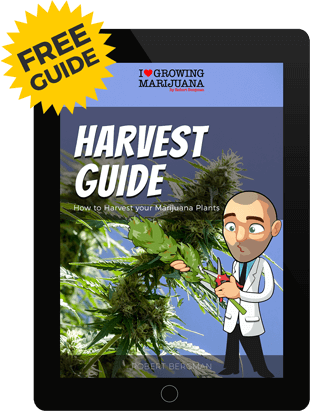
- Time your harvest for Perfect Taste
- Get THC levels for a Perfect High
- Don’t waste any Precious Bud
Error: Contact form not found.
Other Pruning Methods
Besides topping, there are more techniques to prune your plants for more yield. Find a short explanation in my pruning article, or head directly to a technique below:
- Manifolding
- Monstercropping
- Supercropping
- Defoliation
- Sea of Green
- Screen of Green
- Topping
- Fimming
- Schwazzing
- High Stress Training
- Low Stress Training
- Mainlining
FAQs About Low Stress Training Marijuana Plants
Yes – however, you may want to consider skipping the topping part. This is because autoflowers take only 2-3 months to grow which means that they won’t have time to recover if we do the topping wrong.
Yes – just because buds are sprouting doesn’t mean that we stop training the plant. In fact, it’s essential to continue LST once the flowering starts so we can maintain control over the canopy.
LST (when done properly) can often force plants to produce bigger yields.
Becoming an expert marijuana grower requires practice and learning. Let my blog help you get started.
Have you done low stress training on your cannabis plants? Please share your experience or leave questions in the comments section!
Happy growing!
Robert
The post Low Stress Training Marijuana Plants appeared first on I Love Growing Marijuana.

